Friedrich Paulus
| Friedrich Paulus | |
|---|---|
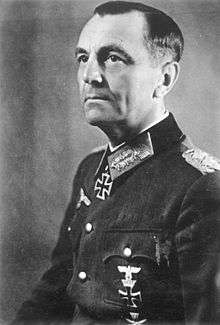 General Friedrich Paulus (1942) | |
| Birth name | Friedrich Wilhelm Ernst Paulus |
| Born |
23 September 1890 Guxhagen, German Empire |
| Died |
1 February 1957 (aged 66) Dresden, East Germany |
| Allegiance |
|
| Years of service | 1910–43 |
| Rank | Generalfeldmarschall |
| Commands held | Sixth Army |
| Battles/wars |
|
| Awards | Knight's Cross of the Iron Cross with Oak Leaves |
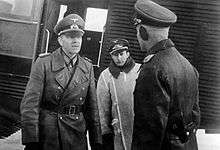
Friedrich Wilhelm Ernst Paulus (23 September 1890 – 1 February 1957) was an officer in the German military from 1910 to 1945. He attained the rank of Generalfeldmarschall (field marshal) during World War II, and is best known for commanding the Sixth Army in the Battle of Stalingrad (August 1942 to February 1943), including the successful advance toward the city of Stalingrad and the less successful attack in 1942 (part of Case Blue, June to November 1942) stopped by the Soviet counter-offensives during the 1942–1943 winter. The battle ended in disaster for Nazi Germany when Soviet forces encircled and defeated about 265,000 personnel of the Wehrmacht, their Axis allies, and the anti-Soviet volunteers. Of the 107,000 Axis servicemen captured, only 6,000 survived captivity and returned home by 1955.
Soviet troops took Paulus by surprise and captured him in Stalingrad on 31 January 1943,[Note 1] the same day on which he was informed of his promotion to field marshal (Generalfeldmarschall) by Adolf Hitler.
Hitler expected Paulus to commit suicide,[2] repeating to his staff that there was no precedent of a German field marshal ever being captured alive. While in Soviet captivity during the war, Paulus became a vocal critic of the Nazi regime and joined the Soviet-sponsored National Committee for a Free Germany. He moved to the German Democratic Republic (East Germany) in 1953.
Early life
Paulus was born in Guxhagen and grew up in Kassel, Hesse-Nassau, the son of a treasurer.[3]
He tried, unsuccessfully, to secure a cadetship in the Imperial German Navy (Kaiserliche Marine) and briefly studied law at Marburg University.
Military career
After leaving the university without a degree, he joined the 111th Infantry Regiment as an officer cadet in February 1910. On 4 July 1912 he married the Romanian Elena Rosetti-Solescu, the sister of a colleague who served in the same regiment.
When World War I began, Paulus's regiment was part of the thrust into France, and he saw action in the Vosges and around Arras in the autumn of 1914. After a leave of absence due to illness, he joined the Alpenkorps as a staff officer, serving in Macedonia, France, Romania and Serbia. By the end of the war, he was a captain.
After the Armistice, Paulus was a brigade adjutant with the Freikorps. He was chosen as one of only 4,000 officers to serve in the Reichswehr, the defensive army that the Treaty of Versailles had limited to 100,000 men. He was assigned to the 13th Infantry Regiment at Stuttgart as a company commander. He served in various staff positions for over a decade (1921–1933) and then briefly commanded a motorized battalion (1934–1935) before being named chief of staff for the Panzer headquarters in October 1935. This was a new formation under the direction of Oswald Lutz that directed the training and development panzerwaffen or tank forces of the German army.
In February 1938 Paulus was appointed Chef des Generalstabes to Guderian's new XVI Armeekorps (Motorisiert), which replaced Lutz's command. Guderian described him as ‘brilliantly clever, conscientious, hard working, original and talented’ but already had doubts about his decisiveness, toughness and lack of command experience. He remained in that post until May 1939, when he was promoted to major general and became chief of staff for the German Tenth Army, with which he saw service in Poland. The unit was renamed the Sixth Army, and engaged in the spring offensives of 1940 through the Netherlands and Belgium. Paulus was promoted to lieutenant general in August 1940. The following month he was named deputy chief of the German General Staff (Oberquartiermeister I). In that role he helped draft the plans for the invasion of the Soviet Union.
Stalingrad
On 5 January 1942, after German Sixth Army's commander Field Marshal Walther von Reichenau, Paulus' patron, became commander of the entire Army Group South, Paulus, who had never commanded a larger unit than a battalion prior to this time, was promoted to General der Panzertruppe and became commander of the Sixth Army.[4] However, he only took over his new command on 20 January, three days after the sudden death of Reichenau,[5] leaving him on his own and without the support of his more experienced sponsor.
Paulus led the drive on Stalingrad during that summer. His troops fought the defending Soviet troops holding Stalingrad over three months in increasingly brutal urban warfare. In November 1942, when the Soviet Red Army launched a massive counter-offensive, code named Operation Uranus, Paulus found himself surrounded by an entire Soviet Army Group.
Paulus followed Adolf Hitler's orders to hold his forces' position in Stalingrad under all circumstances, despite the fact that he was completely surrounded by strong Soviet formations. Operation Winter Storm, a relief effort by Army Group Don under Field Marshal Erich von Manstein was launched in December. Following his orders, Paulus prepared to cooperate with the offensive by trying to break out of Stalingrad. In the meantime, he kept his entire army in fixed defensive positions. Manstein told Paulus that the relief would need assistance from the Sixth Army, but the order to initiate the breakout never came. Paulus remained absolutely firm in obeying the orders he had been given. Manstein's forces were unable to reach Stalingrad on their own and their efforts were eventually halted due to Soviet offensives elsewhere on the front.[5]:137,142,150,153,156
Kurt Zeitzler, the newly appointed chief of the Army General Staff, eventually got Hitler to allow Paulus to break out—provided they continue to hold Stalingrad, an impossible task.
For the next two months, Paulus and his men fought on. However, the lack of food, ammunition, equipment attrition and the deteriorating physical condition of the German troops gradually wore down the German defence. With the new year Hitler promoted Paulus to colonel-general.[5]:164
Regarding the resistance to capitulate, according to Adam, Paulus stated
What would become of the war if our army in the Caucasus was also surrounded? That danger is real. But as long as we keep on fighting, the Red Army has to remain here. They need these forces for a big offensive against Army Group 'A' in the Caucasus and along the still-unstable front from Voronesh to the Black Sea. We must hold them here to the last so that the eastern front can be stabilised. Only if that happens is there a chance of the war going well for Germany."[5]:174
Crisis
On 7 January 1943, General Konstantin Rokossovsky, commander of the Red Army on the Don front, called a cease fire and offered Paulus' men generous surrender terms: normal rations, medical treatment for the ill and wounded, permission to retain their badges, decorations, uniforms and personal effects. As part of his communication, Rokossovsky advised Paulus that he was in an impossible situation. Paulus requested permission from Hitler to surrender. Even though it was obvious the Sixth Army was in an untenable position, the German Army High Command rejected Paulus' request stating, "Capitulation out of the question. Every day that the army holds out longer helps the whole front and draws away the Russian divisions from it."[5]:166–169
After a heavy Soviet offensive overran the last emergency airstrip in Stalingrad on 25 January, the Soviets again offered Paulus a chance to surrender. Paulus radioed Hitler once again for permission to surrender. Paulus stressed that his men were without ammunition or food, and he was no longer able to command them. He also said that 18,000 men were wounded and were in immediate need of medical attention. Once again, Hitler ordered Paulus to hold Stalingrad to the death. On 30 January, Paulus informed Hitler that his men were only hours from collapse. Hitler responded by showering a raft of field promotions by radio on Paulus' officers to build up their spirits and steel their will to hold their ground. Most significantly, he promoted Paulus to Generalfeldmarschall. In deciding to promote Paulus, Hitler noted that there was no known record of a Prussian or German field marshal ever having surrendered. The implication was clear: Paulus was to commit suicide. Hitler implied that if Paulus allowed himself to be taken alive, he would shame Germany's military history.
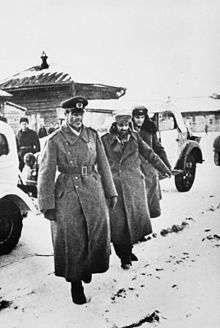
Capitulation
Paulus and his staff were captured on the morning of 31 January 1943. The events of that day were recorded by Colonel Wilhelm Adam, one of Paulus's aides and an adjutant in the XXIII Army Corps, in his personal diary:
January 31, 1943 - 7.00 a.m. It was still dark but day was dawning almost imperceptibly. Paulus was asleep. It was some time before I could break out of the maze of thoughts and strange dreams that depressed me so greatly. But I don't think I remained in this state for very long. I was going to get up quietly when someone knocked at the door. Paulus awoke and sat up. It was the HQ commander. He handed the colonel general a piece of paper and said: 'Congratulations. The rank of field marshal has been conferred upon you. The dispatch came early this morning - it was the last one.''One can't help feeling it's an invitation to suicide. However I'm not going to do them such a favour.' said Paulus after reading the dispatch. Schmidt continued: 'At the same time I have to inform you that the Russians are at the door.' with these words he opened the door and a Soviet general and his interpreter entered the room. The general announced that we were his prisoners. I placed my revolver on the table.
'Prepare yourself for departure. We shall be back for you at 9.00. You will go in your personal car.' said the Soviet general through his interpreter. Then they left the room. I had the official seal with me. I prepared for my last official duty. I recorded Paulus's new rank in his military document, stamped it with the seal then threw the seal into the glowing fire.
The main entrance to the cellar was closed and guarded by the Soviet soldiers. An officer, the head of the guards, allowed me and the driver to go out and get the car ready. Climbing out of the cellar, I stood dumbfounded. Soviet and German soldiers, who just a few hours earlier had been shooting at one another, now stood quietly together in the yard. They were all armed, some with weapons in their hands, some with them over their shoulders.
My God, what a contrast between the two sides! The German soldiers, ragged and in light coats, looked like ghosts with hollow, unshaven cheeks. The Red Army fighters looked fresh and wore warm winter uniforms. Involuntarily I remembered the chain of unfortunate events which had prevented me from sleeping for so many nights. The appearance of the Red Army soldiers seemed symbolic. At 9.00 sharp the HQ commander of the 64th Army arrived to take the commander of the vanquished German 6th Army and its staff towards the rear. The march towards the Volga had ended."[6]
On 2 February 1943 the remainder of the Sixth Army capitulated. Upon finding out about Paulus's 'surrender', Hitler flew into a rage, and vowed never to appoint another field marshal again. He would, in fact, go on to appoint another seven field marshals during the last two years of the war. Speaking about the surrender of Paulus, Hitler told his staff:
In peacetime Germany, about 18,000 or 20,000 people a year chose to commit suicide, even without being in such a position. Here is a man who sees 50,000 or 60,000 of his soldiers die defending themselves bravely to the end. How can he surrender himself to the Bolshevists?![7]
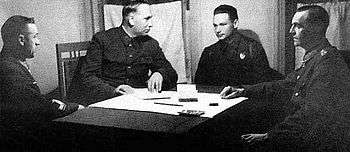
Paulus, a Roman Catholic, was opposed to suicide. During his captivity, according to General Max Pfeffer, Paulus said of Hitler's expectation: "I have no intention of shooting myself for this Bohemian corporal." Another general told the NKVD (the public and secret police organisation of the Soviet Union) that Paulus had told him about his promotion to field marshal and said: "It looks like an invitation to commit suicide, but I will not do this favour for him." Paulus also forbade his soldiers from standing on top of their trenches in order to be shot by the enemy.[8]
Shortly before surrendering, Paulus sent his wedding ring back to his wife on the last plane departing his position. He had not seen her since 1942 and would not see her again, as she died in 1949 while he was still in captivity.[9]
After Stalingrad and postwar
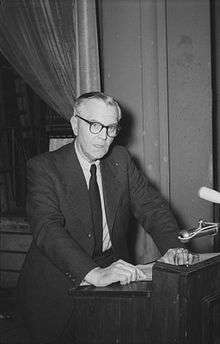
Although he at first refused to collaborate with the Soviets, after the attempted assassination of Hitler on 20 July 1944, Paulus became a vocal critic of the Nazi regime while in Soviet captivity, joining the Soviet-sponsored National Committee for a Free Germany and appealing to Germans to surrender. He later acted as a witness for the prosecution at the Nuremberg Trials. He was allowed to move to the German Democratic Republic in 1953, two years before the repatriation of the remaining German POWs who were held under the pretext that West Germany was not recognised by the Soviet Union, and were used for forced labour.
During the Nuremberg Trials, Paulus was asked about the Stalingrad prisoners by a journalist. Paulus told the journalist to tell the wives and mothers that their husbands and sons were well.[10] Of the 91,000 German prisoners taken at Stalingrad, half had died on the march to Siberian prison camps, and nearly as many died in captivity; only about 6,000 returned home.[Note 2]
From 1953 to 1956, he lived in Dresden, East Germany, where he worked as the civilian chief of the East German Military History Research Institute. In late 1956, he developed amyotrophic lateral sclerosis and became progressively weaker. He died within a few months, in Dresden, on 1 February 1957, 14 years after the surrender at Stalingrad. As part of his last will and testament, his body was transported to Baden, West Germany, to be buried next to his wife, who had died eight years earlier in 1949, not having seen her husband since his departure for the Eastern Front in the summer of 1942.[Note 3]
Awards and decorations
- Iron Cross of 1914, 1st and 2nd class[12]
- Military Merit Order, 4th class with Swords (Bavaria)[12]
- Knight's Cross Second Class of the Order of the Zähringer Lion with swords[12]
- Military Merit Cross, 1st and 2nd class (Mecklenburg-Schwerin)[12]
- Cross for Merit in War (Saxe-Meiningen)[12]
- Military Merit Cross, 3rd class with War Decoration (Austria-Hungary)[12]
- Clasp to the Iron Cross (1939)
- Knight's Cross of the Iron Cross with Oak Leaves
- Knight's Cross on 26 August 1942 as General der Panzertruppe and Commander-in-chief of the 6. Armee[14]
- 178th Oak Leaves on 15 January 1943 as Generaloberst and Commander-in-chief of the 6. Armee[14]
- Order of the Cross of Liberty, 1st class with Oak Leaves and Swords (Finland)
- Order of Michael the Brave, 1st class (Romania)
- Military Order of the Iron Trefoil, First Class with Oak Leaves, (Independent State of Croatia)[15]
- Mentioned in the Wehrmachtbericht on 30 May 1942, 11 August 1942, 31 January 1943, 1 February 1943 and 3 February 1943
Notes
- ↑ "I didn't surrender. I was taken by surprise". (Paulus in conversation with Marshal Voronov).[1]
- ↑ They put the number of POW captured at Stalingrad at 100,000 of whom 6,000 survived.[11]
- ↑ On one of the final Luftwaffe flights out of Stalingrad, Paulus had sent his wedding ring to his wife (Commanders at War, on the Military Channel, 28 May 2010).
References
Citations
- ↑ Beevor 1998, p. 390.
- ↑ "Rise and Fall of the Third Reich, Shirer, digital page 1569
- ↑ Königlich Preußischer Staatsdienst-Kalender für den Regierungsbezirk Cassel auf das Jahr 1890/91. Reformirtes Waisenhaus, Cassel 1891, p. 249 (Corrections- und Landarmen-Anstalt zu Breitenau. ORKA).
- ↑ Glantz & House 2009, p. 22.
- 1 2 3 4 5 Adam, Wilhelm; Ruhle, Otto (2015). With Paulus at Stalingrad. Translated by Tony Le Tissier. Pen and Sword Books Ltd. pp. 2–3. ISBN 9781473833869.
- ↑ 'Meeting The Victors', Sputnik Magazine, 1968, USSR; (English language article).
- ↑ Overy 1997, p. 185.
- ↑ Beevor 1998, p. 381.
- ↑ Battle of Stalingrad - a summary - History in an HourHistory in an Hour
- ↑ Craig 1973, p. 280.
- ↑ Werth et al. Paczkowski 1999, p. 322.
- 1 2 3 4 5 6 Rangliste des Deutschen Reichsheeres (in German). Mittler & Sohn Verlag. 1930. p. 132.
- 1 2 Thomas 1998, p. 143.
- 1 2 Scherzer 2007, p. 585.
- ↑ "Award Document to General der Panzertruppe Paulus, Item Number: EU4642". eMedals. eMedals, n.d. Web. 12 Dec 2013. Archived December 6, 2013, at the Wayback Machine.
Bibliography
- Adam, Wilhelm & Otto Ruhle. With Paulus at Stalingrad, Pen & Sword Books Ltd., England, 2015. ISBN 978-1-47383-386-9.
- Beevor, Antony (1998). Stalingrad, The Fateful Siege: 1942–1943. New York: Penguin Books. ISBN 978-0-670-87095-0.
- Craig, William (1973). Enemy at the Gates. The Battle for Stalingrad. Victoria: Penguin Books. ISBN 0-14-139017-4.
- Glantz, David M.; House, Jonathan (2009). To the Gates of Stalingrad: Soviet-German Combat Operations, April-August 1942. Lawrence, Kansas: University Press of Kansas. ISBN 978-0-7006-1630-5.
- Overy, Richard (1997). Russia's War. United Kingdom: Penguin. ISBN 0-14-027169-4.
- Scherzer, Veit (2007). Die Ritterkreuzträger 1939–1945 Die Inhaber des Ritterkreuzes des Eisernen Kreuzes 1939 von Heer, Luftwaffe, Kriegsmarine, Waffen-SS, Volkssturm sowie mit Deutschland verbündeter Streitkräfte nach den Unterlagen des Bundesarchives [The Knight's Cross Bearers 1939–1945 the Holders of the Knight's Cross of the Iron Cross 1939 by Army, Air Force, Navy, Waffen-SS, Volkssturm and Allied Forces with Germany According to the Documents of the Federal Archives] (in German). Jena, Germany: Scherzers Militaer-Verlag. ISBN 978-3-938845-17-2.
- Thomas, Franz (1998). Die Eichenlaubträger 1939–1945 Band 2: L–Z [The Oak Leaves Bearers 1939–1945 Volume 2: L–Z] (in German). Osnabrück, Germany: Biblio-Verlag. ISBN 978-3-7648-2300-9.
- Werth, Nicolas; Bartošek, Karel; Panné, Jean-Louis; Margolin, Jean-Louis; Paczkowski, Andrzej; Courtois, Stéphane (1999). The Black Book of Communism: Crimes, Terror, Repression. Harvard University Press. p. 858. ISBN 0-674-07608-7.
| Military offices | ||
|---|---|---|
| Preceded by Generalfeldmarschall Walther von Reichenau |
Commander of 6. Armee 30 December 1941 – 3 February 1943 |
Succeeded by General Karl-Adolf Hollidt |
